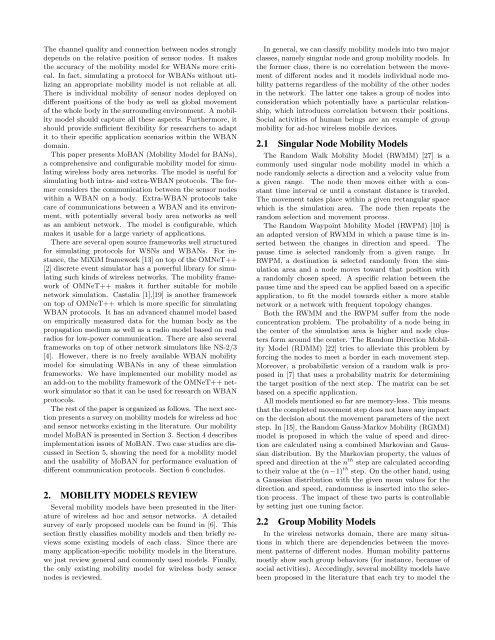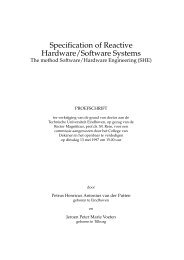MoBAN: A Configurable Mobility Model for Wireless Body Area ...
MoBAN: A Configurable Mobility Model for Wireless Body Area ...
MoBAN: A Configurable Mobility Model for Wireless Body Area ...
Create successful ePaper yourself
Turn your PDF publications into a flip-book with our unique Google optimized e-Paper software.
The channel quality and connection between nodes strongly<br />
depends on the relative position of sensor nodes. It makes<br />
the accuracy of the mobility model <strong>for</strong> WBANs more critical.<br />
In fact, simulating a protocol <strong>for</strong> WBANs without utilizing<br />
an appropriate mobility model is not reliable at all.<br />
There is individual mobility of sensor nodes deployed on<br />
different positions of the body as well as global movement<br />
of the whole body in the surrounding environment. A mobility<br />
model should capture all these aspects. Furthermore, it<br />
should provide sufficient flexibility <strong>for</strong> researchers to adapt<br />
it to their specific application scenarios within the WBAN<br />
domain.<br />
This paper presents <strong>MoBAN</strong> (<strong>Mobility</strong> <strong>Model</strong> <strong>for</strong> BANs),<br />
a comprehensive and configurable mobility model <strong>for</strong> simulating<br />
wireless body area networks. The model is useful <strong>for</strong><br />
simulating both intra- and extra-WBAN protocols. The <strong>for</strong>mer<br />
considers the communication between the sensor nodes<br />
within a WBAN on a body. Extra-WBAN protocols take<br />
care of communications between a WBAN and its environment,<br />
with potentially several body area networks as well<br />
as an ambient network. The model is configurable, which<br />
makes it usable <strong>for</strong> a large variety of applications.<br />
There are several open source frameworks well structured<br />
<strong>for</strong> simulating protocols <strong>for</strong> WSNs and WBANs. For instance,<br />
the MiXiM framework [13] on top of the OMNeT++<br />
[2] discrete event simulator has a powerful library <strong>for</strong> simulating<br />
such kinds of wireless networks. The mobility framework<br />
of OMNeT++ makes it further suitable <strong>for</strong> mobile<br />
network simulation. Castalia [1],[19] is another framework<br />
on top of OMNeT++ which is more specific <strong>for</strong> simulating<br />
WBAN protocols. It has an advanced channel model based<br />
on empirically measured data <strong>for</strong> the human body as the<br />
propagation medium as well as a radio model based on real<br />
radios <strong>for</strong> low-power communication. There are also several<br />
frameworks on top of other network simulators like NS-2/3<br />
[4]. However, there is no freely available WBAN mobility<br />
model <strong>for</strong> simulating WBANs in any of these simulation<br />
frameworks. We have implemented our mobility model as<br />
an add-on to the mobility framework of the OMNeT++ network<br />
simulator so that it can be used <strong>for</strong> research on WBAN<br />
protocols.<br />
The rest of the paper is organized as follows. The next section<br />
presents a survey on mobility models <strong>for</strong> wireless ad hoc<br />
and sensor networks existing in the literature. Our mobility<br />
model <strong>MoBAN</strong> is presented in Section 3. Section 4 describes<br />
implementation issues of <strong>MoBAN</strong>. Two case studies are discussed<br />
in Section 5, showing the need <strong>for</strong> a mobility model<br />
and the usability of <strong>MoBAN</strong> <strong>for</strong> per<strong>for</strong>mance evaluation of<br />
different communication protocols. Section 6 concludes.<br />
2. MOBILITY MODELS REVIEW<br />
Several mobility models have been presented in the literature<br />
of wireless ad hoc and sensor networks. A detailed<br />
survey of early proposed models can be found in [6]. This<br />
section firstly classifies mobility models and then briefly reviews<br />
some existing models of each class. Since there are<br />
many application-specific mobility models in the literature,<br />
we just review general and commonly used models. Finally,<br />
the only existing mobility model <strong>for</strong> wireless body sensor<br />
nodes is reviewed.<br />
In general, we can classify mobility models into two major<br />
classes, namely singular node and group mobility models. In<br />
the <strong>for</strong>mer class, there is no correlation between the movement<br />
of different nodes and it models individual node mobility<br />
patterns regardless of the mobility of the other nodes<br />
in the network. The latter one takes a group of nodes into<br />
consideration which potentially have a particular relationship,<br />
which introduces correlation between their positions.<br />
Social activities of human beings are an example of group<br />
mobility <strong>for</strong> ad-hoc wireless mobile devices.<br />
2.1 Singular Node <strong>Mobility</strong> <strong>Model</strong>s<br />
The Random Walk <strong>Mobility</strong> <strong>Model</strong> (RWMM) [27] is a<br />
commonly used singular node mobility model in which a<br />
node randomly selects a direction and a velocity value from<br />
a given range. The node then moves either with a constant<br />
time interval or until a constant distance is traveled.<br />
The movement takes place within a given rectangular space<br />
which is the simulation area. The node then repeats the<br />
random selection and movement process.<br />
The Random Waypoint <strong>Mobility</strong> <strong>Model</strong> (RWPM) [10] is<br />
an adapted version of RWMM in which a pause time is inserted<br />
between the changes in direction and speed. The<br />
pause time is selected randomly from a given range. In<br />
RWPM, a destination is selected randomly from the simulation<br />
area and a node moves toward that position with<br />
a randomly chosen speed. A specific relation between the<br />
pause time and the speed can be applied based on a specific<br />
application, to fit the model towards either a more stable<br />
network or a network with frequent topology changes.<br />
Both the RWMM and the RWPM suffer from the node<br />
concentration problem. The probability of a node being in<br />
the center of the simulation area is higher and node clusters<br />
<strong>for</strong>m around the center. The Random Direction <strong>Mobility</strong><br />
<strong>Model</strong> (RDMM) [22] tries to alleviate this problem by<br />
<strong>for</strong>cing the nodes to meet a border in each movement step.<br />
Moreover, a probabilistic version of a random walk is proposed<br />
in [7] that uses a probability matrix <strong>for</strong> determining<br />
the target position of the next step. The matrix can be set<br />
based on a specific application.<br />
All models mentioned so far are memory-less. This means<br />
that the completed movement step does not have any impact<br />
on the decision about the movement parameters of the next<br />
step. In [15], the Random Gauss-Markov <strong>Mobility</strong> (RGMM)<br />
model is proposed in which the value of speed and direction<br />
are calculated using a combined Markovian and Gaussian<br />
distribution. By the Markovian property, the values of<br />
speed and direction at the n th step are calculated according<br />
to their value at the (n−1) th step. On the other hand, using<br />
a Gaussian distribution with the given mean values <strong>for</strong> the<br />
direction and speed, randomness is inserted into the selection<br />
process. The impact of these two parts is controllable<br />
by setting just one tuning factor.<br />
2.2 Group <strong>Mobility</strong> <strong>Model</strong>s<br />
In the wireless networks domain, there are many situations<br />
in which there are dependencies between the movement<br />
patterns of different nodes. Human mobility patterns<br />
mostly show such group behaviors (<strong>for</strong> instance, because of<br />
social activities). Accordingly, several mobility models have<br />
been proposed in the literature that each try to model the

















